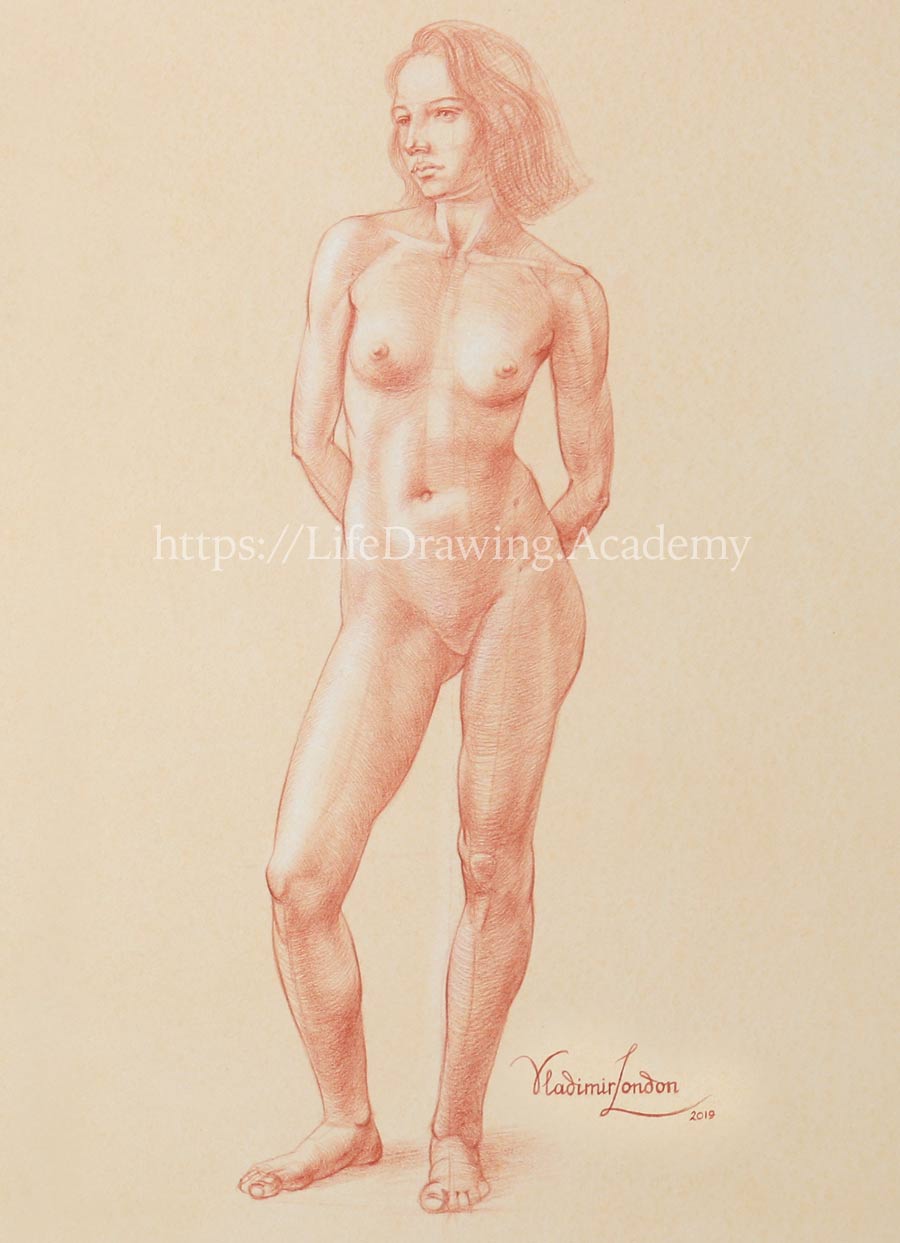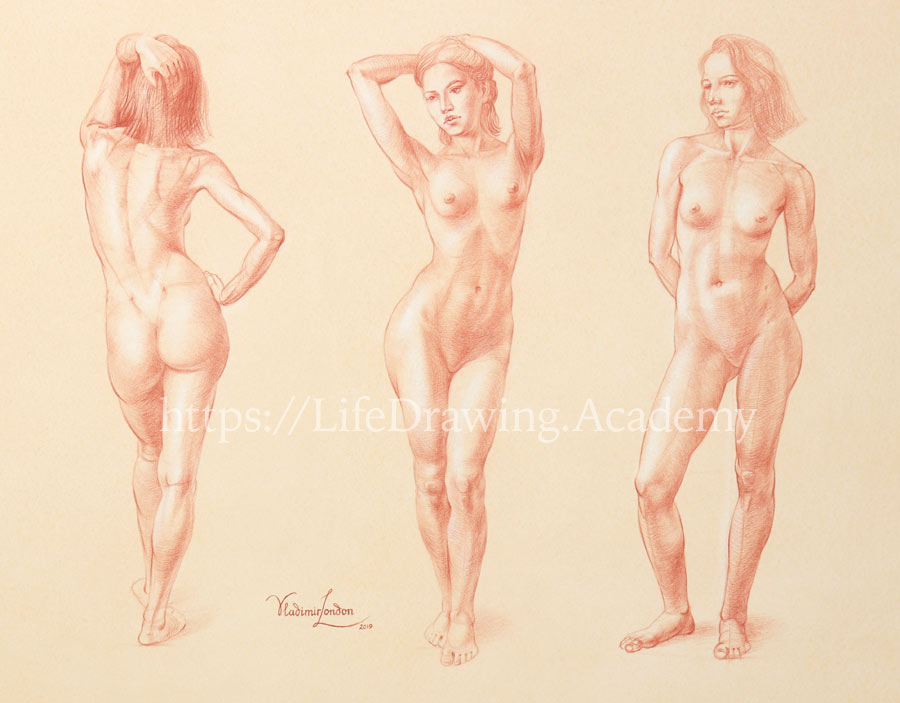Model Drawing
This is your unique chance to get a lifetime academy membership and a dedicated team of art teachers.
Such unlimited personal tutoring is not available anywhere else.
Enroll in the Life Drawing Academy now!
Model Drawing
Life Drawing by Vladimir London
In this video lesson, you will discover how to use human body proportions when drawing a model standing in contrapposto. This artwork is done in red pencil on 100% cotton paper tinted with watercolor. In the previous lesson, we examined the classical canon of proportions that are suited for contrapposto. It is based on a measurement of seven and a half heads. The middle of the figure coincides with the pubic bone. And there are three dimensions that help to depict a torso and legs.

Let's begin Model Drawing by marking the top of the head and the level of the toes. The height of the figure is divided in half. This is the pubic bone level. The pelvis is tilted in contrapposto. The direction of this tilt is measured in life and applied in drawing. The top part is halved. One-fourth of the figure is halved as well, giving one-eighth. We add a bit to that measurement to mark the height of the head.
The head is indicated roughly at this step. One-half of the face can be compared to the distance from the chin to the pit of the neck. The line of the shoulders is tilted. The distance from the pit of the neck to the pubic bone is the same as the distance from the toes to the top of the kneecap. It is the same from the top of the kneecap to the top of the pelvis. The height of the head is equal to the height of the pelvis.
The spinal column is laterally curved. This is due to the pelvis' tilt, which is in the opposite direction to the shoulders' line. The navel is on the same level as the top of the pelvis. The height of the face fits approximately two times from the pit of the neck to the navel. This is also the distance from the navel to the pubic bone. The plane of the first pair of ribs is tilted and depicted as an oval. Its width is about one-half of the head's height. The cranium's height fits two times into the ribcage's height.
The bottom edge of the ribcage follows the tilt of the shoulders. The shape of the ribcage resembles an egg. The width of the ribcage is a bit greater than the head's height. It is also slightly smaller than the width of the pelvis, which is equal to the distance from the top of the head to the pit of the neck. The direction of the tilt of the hip can be measure in life and applied in drawing. The same can be done for the other hip. The axis of the hip joints is slightly higher than the middle of the figure. The hip joints coincide with the sides of the pelvis. The bottom of the pelvis is slightly lower than the middle of the figure. The supporting leg's axis is tilted. The height of the head fits two times from the hip joint to the knee. The distance from the pit of the neck to the pubic bone is the same as from the toes to the top of the kneecap. It is also the same as from the kneecap to the top of the pelvis. This proportion locates the kneecap.
The line between the two knees has a tilt. It follows the inclination of the pelvis. The height of the face fits twice in the distance from the knee joint to the top of the foot. The height of the face is equal to the length of the collarbone. The shoulder joints are on both sides of the ribcage. The bone of the upper arm ends at the ribcage's bottom edge.

We make sure that both upper arms have the same length. The height of the head fits seven and a half times into the figure's height. The head fits once from the seventh vertebra to the breastbone's end. It is also equal to the height of the pelvis. This measuring unit also fits two times from the hip joint to the knee joint, as well as from the knee joint to the toes of the supporting leg.
The height of the face is the same as:
- the height of the breastbone;
- the distance from the breastbone to the navel or top of the pelvis;
- and the distance from the navel to the pubic bone.
The height of the face fits twice into the shinbone. We can also double-check the middle of the figure, which is on the pubic bone level. The medial upper leg's outline is defined by the adductor muscles.
There are two important landmarks of the pelvis. From this point, the tailors' muscle spirals around the upper leg and inserts below the knee at its medial side. The straight portion of the quadriceps occupies the front part of the thigh. The lateral portion and the fascia form the lateral outline of the upper leg. The buttocks muscles always have some fat on top, which gives an individual outline.
I start to draw the relaxed leg with its kneecap as an important landmark. The cross-section of the knee-joint is presented as an oval. The quadriceps spans from the pelvis to the knee. The tailors' muscle gives another characteristic contour of the upper leg. Together with the adductor muscles, it forms the medial outline of the leg. When drawing legs, it is helpful to check the negative space between legs. This triangle can be compared to the shape in life. The two collarbones follow the tilt of the shoulder line.
Let's check the ribcage contours. The ribcage is not strictly vertical but tilted backward. That is why we see its contours from below. Such contours are indicated as ovals.
The chest muscle inserts to the upper arm bones. It has three portions:
- the collarbone portion at the top;
- the breastbone portion in the middle;
- and the lower portion.
The widest muscle of the back also inserts into the upper arm bones.
The torso in contrapposto is twisted and also bent sideways. That is why one side is compressed, and the other is stretched. This geometry is depicted in drawing...
[ The full lesson is avaibale to Life Drawing Academy members ]
This is your unique chance to get a lifetime academy membership and a dedicated team of art teachers.
Such unlimited personal tutoring is not available anywhere else.




